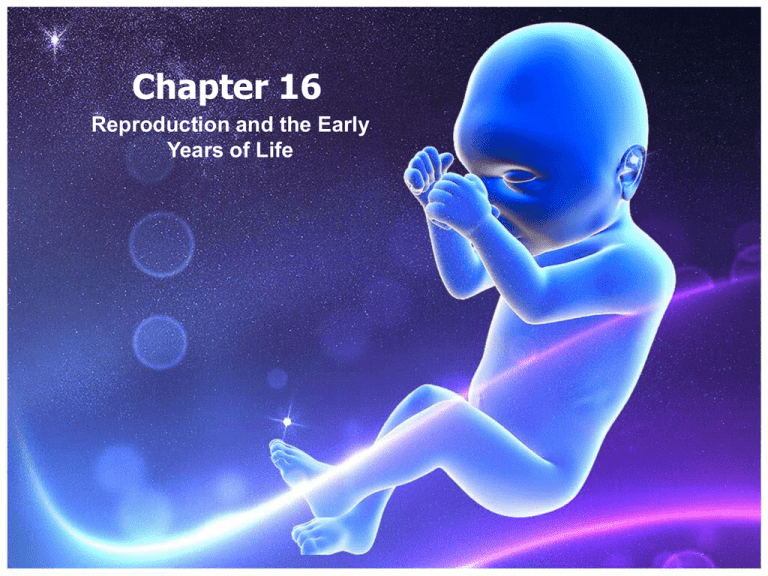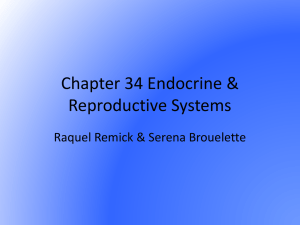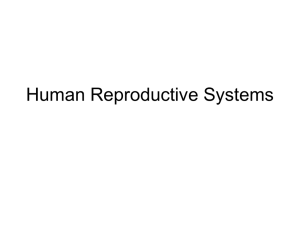
Chapter 16
Reproduction and the Early
Years of Life
Chapter 16 Vocabulary
• Fertilization – the union of a sperm and an egg
• Sperm – male gametes or reproduction cell; contains
one-half of the instructions needed for the
development of a new human being
• Egg – Female reproductive cell, also called an ovum;
contains one-half of the instructions needed for the
development of a new human being
• Testes – two small glands that secrete testosterone
and produce sperm
• Penis – tube-shaped organ that extends from the
trunk of the body just above the testes
• Ovaries – female reproductive structures that
produce eggs and female sex hormones
• Ovulation – the release of an egg from an ovary
Chapter 16 Vocabulary
• Vagina – female reproductive structure that
receives the sperm
• Cervix – the base of the uterus, which bulges down
into the vagina; has a small opening through which
sperm can enter the uterus
• Uterus – the hollow muscular organ that provides a
place for the baby to grow before birth; also called
the womb
• Pap test – a medical procedure in which cells from
the cervix are removed and tested for cancer
• Embryo – a fertilized egg after it has attached itself
to the wall of the uterus
• Fetus – a developing individual from the ninth week
of pregnancy until birth
Chapter 16 Vocabulary
• Semen – a thick fluid containing sperm and other secretions from the
male reproductive system
• Testosterone – the male sex hormone
• Sterility – the inability to reproduce
16.1 The Endocrine System
• The endocrine glands are ductless or tubeless organs or groups of cells
that secrete hormones directly into the bloodstream
• Hormones are chemicals substances that help regulate many of your
body’s functions
• The adrenal glands help the body deal with stress and respond to
emergencies
• Maintaining Your Endocrine Health
– Eat balanced meals to ensure that you get nutrients you need, and use
stress-management techniques
– Sleep is also important to the endocrine health
– Engage in regular physical activity to keep your body strong
– Also have regular medical checkups
• Stress, infection, and changes in the balance of fluid and minerals in the
blood can cause hormone levels to fluctuate
16.1 The Endocrine System
16.2: The Male Reproduction
System
• Life is the result of the union of a sperm cell from a male and an
egg cell or ovum from a female
• The union of the sperm and egg is called fertilization
• Each sperm and egg contain one half of the instructions needed
for the development of a new, unique human being
• The process of producing a new individual is called
reproduction or having children
• One job of the male reproduction system is to produce sperm
and transport them into the body of the female
• Figure 16.5 The Parts of the Male Reproduction System
– Scrotum is the loose sac under the penis. Inside are two
testes which produce sperm
– The Vas deferens connects the testes and the penis and the
sperm travels through this tube
– Along the way are glands that produce fluids that nourish
and protect the sperm
16.2 The Testes
• Testes also called testicles are two egg-shaped
structures that hang inside the scrotum
• Two functions for the testes:
– Make sperm – testes hang away from the body
so that the temperature inside them is slightly
cooler than the rest of the body
• If temp. is too high the sperm will not
fertilize an egg: defective
• Testes produce about 50,000 sperm every
minute
– Produce the male sex hormone testosterone
• Testosterone is necessary for sperm
production and the development of male sex
characteristics
• At puberty the amount of testosterone increases
which causes boys bodies to change
16.2: The Vas Deferens and the
Urethra
• Sperm must be able to leave the body for reproduction to
occur
• After sperm is made in the testes, they travel to a structure
called the epididymis, located at the top of each testis
• In the epididymis sperm become fully mature
• After about two to 10 days, the sperm leave the epididymis
and travel through a tube called the vas deferens. Males
have two of these tubes
• The vas deferens tubes lead to the urethra, which is the
tube that runs through the center of the penis
• The sperm and urine leaves the body through the urethra
• Along the way sperm pass by glands that add fluids to the
sperm. These nourish and protect the sperm, and enable
the sperm to move on their own. The addition of these
fluids to the sperm creates the fluid called semen
16.2: The Penis
• Through the penis the sperm reaches the inside of the female’s
body
• During sexual excitement the arteries leading to the penis open
wider, allowing more blood to flow into the penis. At the same
time some of the veins in the penis close or narrow so that less
blood flows out
• The accumulated blood causes the penis to become larger, longer,
and firmer and to point upward instead of hanging downward
• This state is an erection which makes it possible for the penis to be
inserted into the female’s vagina
• Ejaculation is the process by which semen leaves the body
– During ejaculation, muscles around the urethra and the base of
the penis contract. The contraction moves the sperm out of the
body
– Ejaculation is also called an orgasm
– Ejaculation can occur during sleep called nocturnal emission or
a “wet dream”
16.2: Pathways to Fertilization
• During sexual intercourse the sperm are deposited inside the
female’s vagina, a few inches from the egg
• From a sperm’s point of view, this is a long and difficult
journey
– Each sperm has a tail that propels it forward
– Sperm are streamline and much smaller than most cells in
the body. Their streamline shape and small size make it
easier for them to swim quickly
• The semen in one ejaculation contains 40 million to 400
million sperm
• So many are released because the majority of the sperm will
never make it to the egg
– Sperm will become trapped in mucus or die on the way
• Millions are also released because the presence of many
sperm is necessary to help one sperm fuse with an egg
16.2: Pathways to Fertilization
cont…
• The egg is protected by a layer of many smaller cells
• Sperm contain enzymes that break down this layer of cells
• Only after many sperm have released their enzymes can one sperm make
it to the inside of the egg
• After one sperm has made it inside, a protective shield forms, which
prevents other sperm from fusing with the egg
16.2: Disorders of the Male
Reproduction System
• Something can go wrong with the male reproduction system
even if he takes good care of himself
• Testicular Torsion – means “twisted testis”
– Really means spermatic cord, which suspends each
testis in the scrotum and contains many blood vessels
– Can become twisted during strenuous exercise or even
during sleep
– Very rare, but its an emergency situation. Testicular
torsion can destroy the testes. Pain in the groin
• Undescended Testes – One or both testes remain inside the
body rather than hanging loose in the scrotum
– If testes don’t descend into the scrotum by 2 yrs old
medical treatment is necessary
– Undescended testes are more likely to cause cancer
– Infertility may result
16.2: Disorders of the Male Reproduction System
• Inguinal Hernia – Sometimes part of an intestine protrudes into the
scrotum through a weakness in the abdominal wall
– It’s painful and require surgery to correct
• Infertility – Being unable to reproduce
– Males infertility means he has too few sperm or his sperm are
unable to fertilize an egg
– Caused by exposure to harmful drugs or X rays, the
development of testicular mumps as an adult, or a genetic
defect
– Medical treatments are available for many kinds of male
infertility
• Enlarged Prostate Gland – Prostate gland obstructs the outlet of the
urinary bladder. Very dangerous and uncomfortable
• Prostate Cancer – Requires surgical treatment
– Most common cancer in American males
– 2nd most common cause of deaths due to cancer in American
males
16.2: Disorders of the Male Reproduction System
• Testicular Cancer – Cancer of the testes
– Most common form of cancer in males between 15 and 35
– If detected and treated early, there is an excellent chance of recovery
– Monthly examination of testes for early detection is suggested
• Care of the Male Reproductive System – A few simple steps to take care of
the male reproductive organs
– Wash the penis and scrotum daily, and check for sores or bumps
– Don’t wear extremely tight clothing. Can cause pain
– Do the testicular self-examination once a month to detect lumps or
other abnormalities to detect early signs of cancer
How to do a testicular self-examination - males
1. The best time is after a warm bath or shower, when the scrotum is relaxed
2. Stand in front of a mirror and look for any swelling of the scrotum
3. Check for any lumps, enlargements, tenderness, or change in texture by rolling each
testicle gently between your thumb and fingers
4. If you notice any abnormalities, report them to your doctor. Perform monthly
16.3 The Female Reproduction
system
• The job of the female reproduction system is to produce an egg and to
provide a place where the egg and the sperm can join
• After the union of egg and sperm the fertilized egg begins its development
into a new individual
• The female reproduction system provides the new individual with shelter
and nourishment for the nine months before birth
• After birth a woman’s breasts are able to provide nourishment in the form
of milk
• Breast are part of the female reproductive system
16.3: The Vagina, Cervix, and Ovaries
• The vagina is a muscular tube that receives the
sperm
• The upper end of the vagina is the cervix, which has
a small opening through which sperm can enter the
uterus
• During birth the baby pass through the cervix and
vagina, so the vagina is sometimes called the birth
canal
• The ovaries are located in the lower part of the
abdomen. One on each side of the uterus. Two
Functions of the ovaries:
– Produce the eggs – usually only one mature egg
at a time
– Product sex hormones – these hormones called
estrogen and progesterone cause girly features
and the monthly release of an egg and
menstrual cycle
• Ovulation is the release of an egg from an ovary
16.3: The Fallopian Tubes and the
Uterus
• Once an egg is mature fluid sweeps it from the ovary into the
fallopian tube which takes it to the uterus
• Fertilization occurs in the fallopian tube
• If the sperm meets the egg in the upper third of the fallopian
tube, it can be fertilized
• If the egg is not fertilized within 12 to 24 hours after its release
from the ovary it begins to break down
• The eggs continues to travel toward the uterus fertilized or not
• It reaches the uterus four or five days after leaving the ovary
• Unfertilized it will dissolve in the uterus, fertilized it will
implant in the wall of the uterus, where it will grow into an
embryo
• The uterus is a muscular organ about the size of a fist
sometimes called the womb
– Main job is to provide a place for the baby to grow
16.3: The menstrual Cycle
•
•
•
•
•
The uterus undergoes cyclical changes monthly,
which prepare it to receive and nourish a
fertilized egg. These changes are called the
menstrual cycle
During the menstrual cycle, the inner lining of the
uterus thickens, and many tiny blood vessels grow
into the thickened lining
These changes are caused by sex hormones
One of two things can happen from these
changes
– If the egg has been fertilized, hormones are
released that tells the uterus to maintain its
thickened lining. She is pregnant
– The egg was not fertilized the thickened
uterine lining breaks down and the female
menstruates
Except during pregnancy a woman release an egg
every month from puberty until about the age of
50
16.3: The menstrual Cycle
• If the egg is not fertilized the blood vessels of the lining close up
and then break
• The cells of the lining comes loose from the inside of the uterus
• Blood from the broken vessels help to wash these cells out of the
uterus
• The mixture of blood and cells is call menstrual fluid
• The time during which the menstrual fluid flows out the body is
called the menstrual period . Usually last from three to seven days
• After the menstrual period is completed, the uterus begins to
prepare a new thicken lining that will be ready for the next egg
• The average menstrual cycle last 28 days. The time from the first
day of a menstrual period until the first day of the next period
• This cycle can vary for some women and that is an irregular cycle
• Age of the first menstrual period varies between 12 and 14 and
some 10
• All of these individual differences are perfectly normal
16.3: Disorders of the Female
Reproduction System
• Menstrual cramps are very common
– Felt in the lower abdominal area caused by the contracting
of the uterus
– Warm bath and exercise can relieve cramps, medication
OTC’s, if nothing helps see the doctor
• PMS (Premenstrual Syndrome) are problems experienced
before the menstrual period
– Swelling and tenderness of the breasts, irritability, bloated
feeling, constipation, headaches, and fatigue, depression,
crying, anxiety, and anger
– Usually occur one to two days before the period but may
happen sooner
– Reduce intake of salt and sugar, avoid caffeine and nicotine,
regular exercise and relaxation exercises can help
16.3: Disorders of the Female Reproduction
System
• Vaginitis (Bacterial Vaginosis) is something that most women will have at
some point in their lives
– Itching or soreness of the vulva, unpleasant odor, increase in discharge
from the vagina, and sometimes a burning sensation
– Douching for vaginitis is not recommended
– Important to know most fluids from the vagina are perfectly normal. If
fluid is whitish and nonirritating it is probably normal
• Toxic Shock Syndrome a rare but dangerous bacterial infection that affects
the immune system and the liver
– Associated with the use of highly absorbent tampons
– Tampons should be changed frequently at least every 4 to 6 hours
– High fever, nausea, diarrhea, dizziness, and a sunburn-like rash on the
palms of hands or bottom of feet
– Can cause death, go to the emergency room
• Ovarian Cysts is a growth on the ovary
– A woman may have pain or no symptoms
16.3: Disorders of the Female Reproduction
System
• Cancers can occur in any part of the woman’s reproductive
system
– Doctors recommend that all sexually active females,
regardless of age have a yearly pelvic examination to detect
cancers early
– Pap test are used during the exam, in which cells from the
cervix are removed and tested for cancer
– Women should check their breast for lumps and other
abnormalities each month
• Infertility means unable to have children
– Most common cause is failure to ovulate – to release an egg
– Underweight women because of eating disorders or
excessive exercise do not ovulate
– Scar tissue in the fallopian tubes. May be the result of
surgery or infection
– Sexually transmitted diseases
16.3: Care of the Female Reproduction
System
• Take the following simple stems to keep everything working
smoothly
– Wash the external reproductive organs daily with a mild,
nonirritating soap. Feel for any unusual bumps or sores
– Don’t use “feminine hygiene” sprays
– Don’t use douches unless they are medicated douches
recommended for you by your doctor
– During menstruation, change sanitary pads or tampons often,
at least 4-6 hours. Don’t use deodorant tampons, or tampons
with greater absorbency than you need
– Visit a health care provider once a year to make sure that
your reproductive system is healthy
– Perform a monthly breast self-examination to find lumps or
other abnormalities
16.3: How to do a Breast SelfExamination
p. 455: Do a breast self exam once a month. Two or three days
after your menstrual period ends is the best time
1. Stand in front of a mirror and look carefully at your breasts.
Look for anything unusual, discharge or puckering, dimpling
2. Clasp your hands behind your head and press your hands
forward
3. Press your hands firmly on your hips and bow slightly forward
4. Raise your left arm. Use your fingers to examine your left
breast. Beginning at the outer edge of your breast
5. Gently squeeze each nipple, and look for any discharge
6. Lie down and put a pillow or folded towel under your left
shoulder. Raise your left arm, and examine the same way you
din in step 4
Chapter 17.1 Pregnancy, Birth, and Childhood
Development
– Before fertilization the sperm and egg are two separate cells
which each contain ½ of the information needed for the
development of a new person
– After fertilization there is only one cell that contains all the
information needed for the development of a new person
– After ejaculation, it takes the sperms between 15 mins and an
hour to reach the fallopian tube and fertilize the egg
– The fertilized eggs travels toward the uterus
– 30 hours after fertilization the egg divides into two cells
– The two cells then divide into four cells and the four into eight
and so on
– About four days after fertilization, the fertilized egg finally
reaches the uterus
– The eggs rests on the soft, thick lining of the uterus, it begins
to burrow into the lining. It’s now an embryo
– By the 10th day the embryo contains thousands of cells and is
completely buried in the uterine wall. This is implantation
17.1: From Mother to Baby
• The embryo implants itself into the wall of the
uterus and use all the nutrients that were
stored in the egg before fertilization
• The placenta is the structure that allows the
embryo to get what it needs from the mother
• The placenta is a disc-shaped organ that is
attached to the inner wall of the uterus
• It is connected to the embryo by a structure
called the umbilical cord
• Oxygen, antibodies, and nutrients from the
mother’s blood diffuse through the walls of
the embryo’s blood vessels in the placenta
• These things then travel through the blood
vessels in the umbilical cord to the baby
17.1: Changes During Pregnancy
• Once implanted the embryo grows rapidly
• A heart and brain begin to form. Eyes appear and the face takes
shape
• Small buds on the sides of the body become arms and legs
• Internal organs like the lungs, stomach, and liver are developing
• The embryo floats in a warm, fluid-filled pouch called the
amniotic sac
• Eight weeks after fertilization the embryo is only 30 mm long (a
little over an inch), but all the major organs are formed and
growing
• From the ninth week until birth, it is called a fetus
• Pregnancy test look for HCG (human chorionic gonadotropin)
• After three weeks a female will have enough HCG in her blood
and urine for a positive test
17.1: Development Inside the Uterus
17.1 Childbirth
• 1st a month or two before birth, the fetus
drops to a lower position
• 2nd in the 1st stage of delivery (dilation),
strong uterine contractions cause the
cervix to dilate
• 3rd the cervix has completely dilated by
the end of this stage
• 4th During the second stage (expulsion),
the head emerges fully and the shoulders
rotate
• 5th By the third stage (placental), the baby
has been born. The uterus expels the
placenta and the umbilical cord
• The final stage is when contractions are
strong enough to push the baby out is
labor (between 5 and 20 hours)
17.1: Complications of Pregnancy
and Birth
Ectopic Pregnancy
The pregnancy tissue or embryo becomes implanted in the fallopian
tube or somewhere else in the abdomen besides the uterus
Miscarriage
(spontaneous
abortion)
The pregnancy tissue or embryo is expelled from the uterus before it is
sufficiently developed. Can be caused by genetic defects, illness in the
mother, drugs. Usually within 1-3 months
Toxemia
Mother has high blood pressure, swelling, and protein in the urine.
Untreated toxemia can result in convulsions, coma, and death of both
the mother and infant
Rh incompatibility
A woman’s blood produces an antibody that attacks a substance in the
infant’s blood cells. May occur if mother is Rh negative and infant is Rh
positive. This can be avoided by an injection that prevents a woman’s
blood from making the Rh antibody
Premature birth
A baby is born before it’s fully developed. If born before 37 weeks
Cesarean section
An incision through the abdomen and uterus
Multiple births
Two or more infants are born together
Stillbirth
An infant that is born dead 22 weeks or more after conception
Questions
Active Learning
• Create informational brochures that describes to
younger female and male students what happens
to their bodies as they mature. Target your
brochures to adolescents between the ages of 8
and 13. Include illustrations and use information
that is well organized and easy to understand.
– Females include information about
menstruation - what it is, what happens to the
body, why it happens, and how to manage the
changes.
– Males include information on how to maintain
reproductive health and how to do a testicular
self-exam (TSE)








